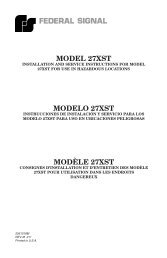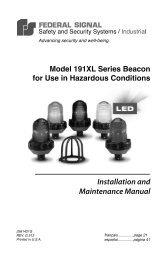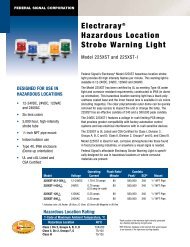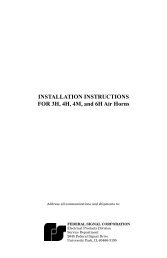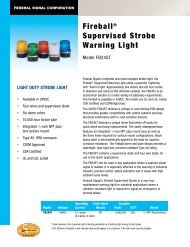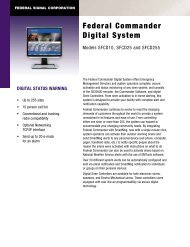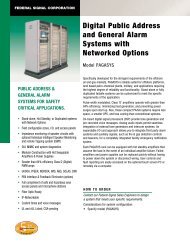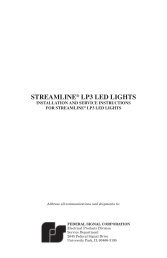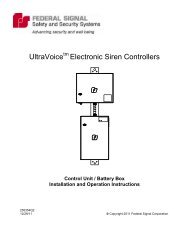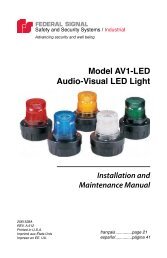SFCD: Federal Commander Digital System - Federal Signal
SFCD: Federal Commander Digital System - Federal Signal
SFCD: Federal Commander Digital System - Federal Signal
Create successful ePaper yourself
Turn your PDF publications into a flip-book with our unique Google optimized e-Paper software.
<strong>Federal</strong> <strong>Commander</strong> <strong>Digital</strong> <strong>System</strong><br />
This checkbox field controls whether or not AC power fail will be auto reported from this RTU. If<br />
enabled this RTU will auto report power fail when it occurs. If disabled power fail will not be auto<br />
reported however they will be sent when this RTU is polled.<br />
Time Encryption<br />
The Time Encryption option, when enabled adds extra security against malicious operation. This<br />
is accomplished by comparing the base station's time and date encoded into the activation<br />
message with the rtu's (siren) time. If they differ by a predetermined amount, the siren will not<br />
sound and a sync fail error will occur. It is recommended that this option not be used unless<br />
malicious operation by recording activation signals is a problem. There is a potential the sirens<br />
may fail to operate when called upon if the time clocks drift out if sync.<br />
Trunking Mode (ENABLED/ DISABLED)<br />
This checkbox field controls trunking mode. Trunking mode is used only for selected trunking<br />
transceivers and should normally be disabled.<br />
Repeater General Information<br />
A repeater is a normal RTU that is used as a communication link between the CCU and a target<br />
RTU.<br />
The best possible situation is that the CCU will be able to communicate directly with every RTU in<br />
the network. In this situation, no repeaters are needed to reach any RTU.<br />
In real life there are usually RTUs that the CCU cannot communicate with directly because the<br />
distance is too great, or there is some object in between the CCU and RTU. In this situation, up to<br />
four repeaters can be used to reach any RTU.<br />
If the CCU does not need to use repeaters to be able to communicate with an RTU, both RTU<br />
Repeater Set #1 and RTU Repeater Set #2 will contain blanks for all RTU numbers. If Repeater<br />
Set #1 is blank and Set #2 contains repeaters, the CCU will first attempt to communicate using<br />
the direct path and retry using Set #2 only if the direct path fails.<br />
If the CCU does need to use repeaters to be able to communicate with an RTU, RTU Repeater<br />
Set #1 will contain one or more RTU numbers, and RTU Repeater Set #2 can optionally contain a<br />
different set of RTU numbers. If any repeaters are specified for RTU Repeater Set #1, they will<br />
always be used in any communication attempt with this RTU. If any repeaters are specified for<br />
RTU Repeater Set #2, they will only be used if the CCU is unable to communicate with this RTU<br />
using RTU Repeater Set #1.<br />
The CCU will then wait the number of seconds indicated in the Retry Delay field of the <strong>System</strong><br />
Setup window for a reply from the RTU. If no reply is received within the Retry Delay time, and if<br />
the # Tries field on the <strong>System</strong> Setup window is greater than 1, the CCU will try again to<br />
communicate with the RTU, using the same repeaters as before, if any. The CCU will attempt to<br />
communicate with this RTU with the same repeaters (if any) as many times as the # Tries field<br />
indicates.<br />
The CCU will again wait the indicated number of seconds. If no reply is received again, the CCU<br />
will generate a Comm Fail alarm message for the Alarm Log, with the CCUs date and time of<br />
when the last failure occurred. Then if the CCU used any repeaters for the first attempt(s), and if<br />
there are any repeaters specified in RTU Repeater Set #2, the CCU will again attempt to<br />
communicate with the RTU using the repeaters from RTU Repeater Set #2. During an All Poll the<br />
134<br />
RTU



